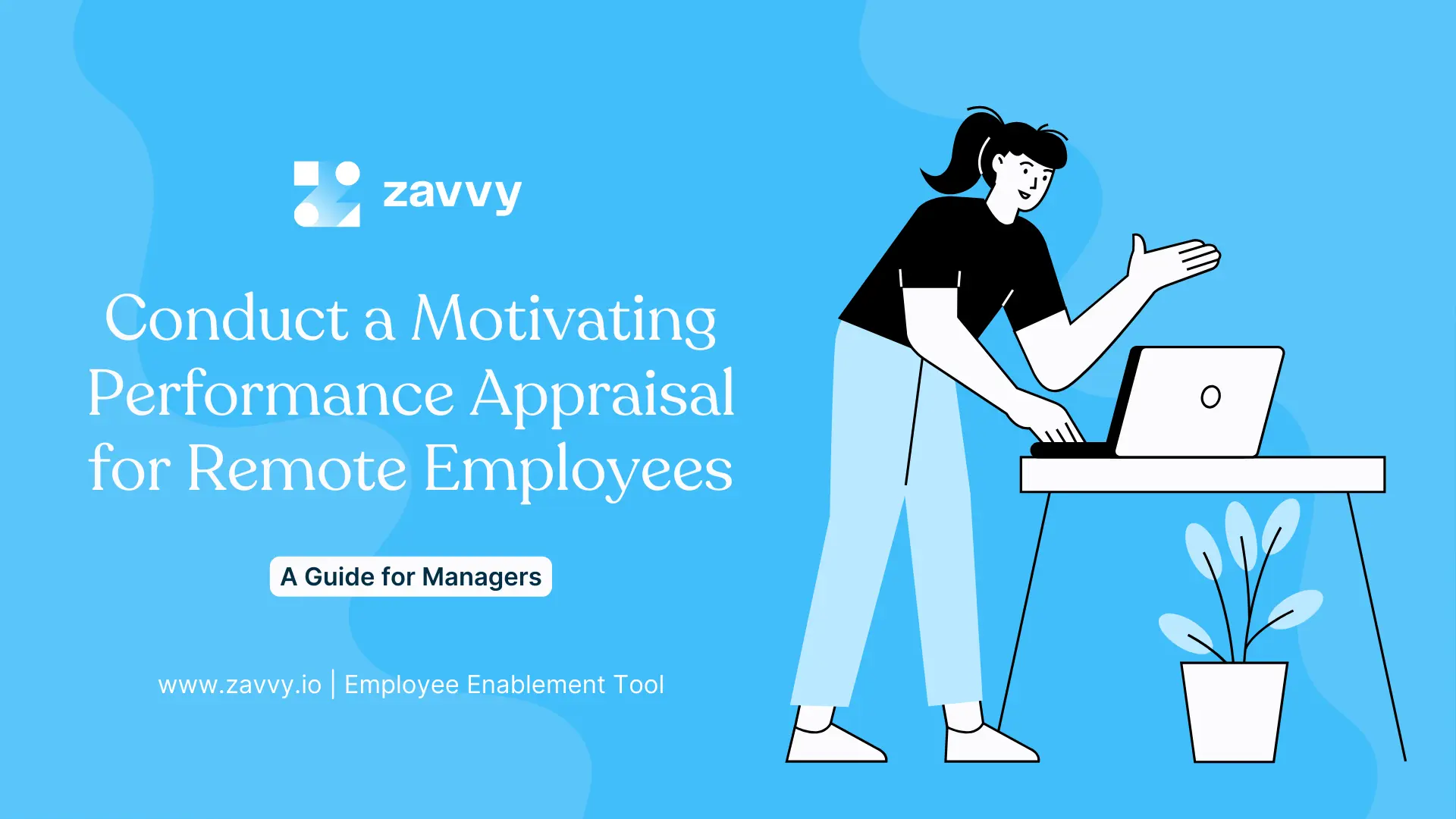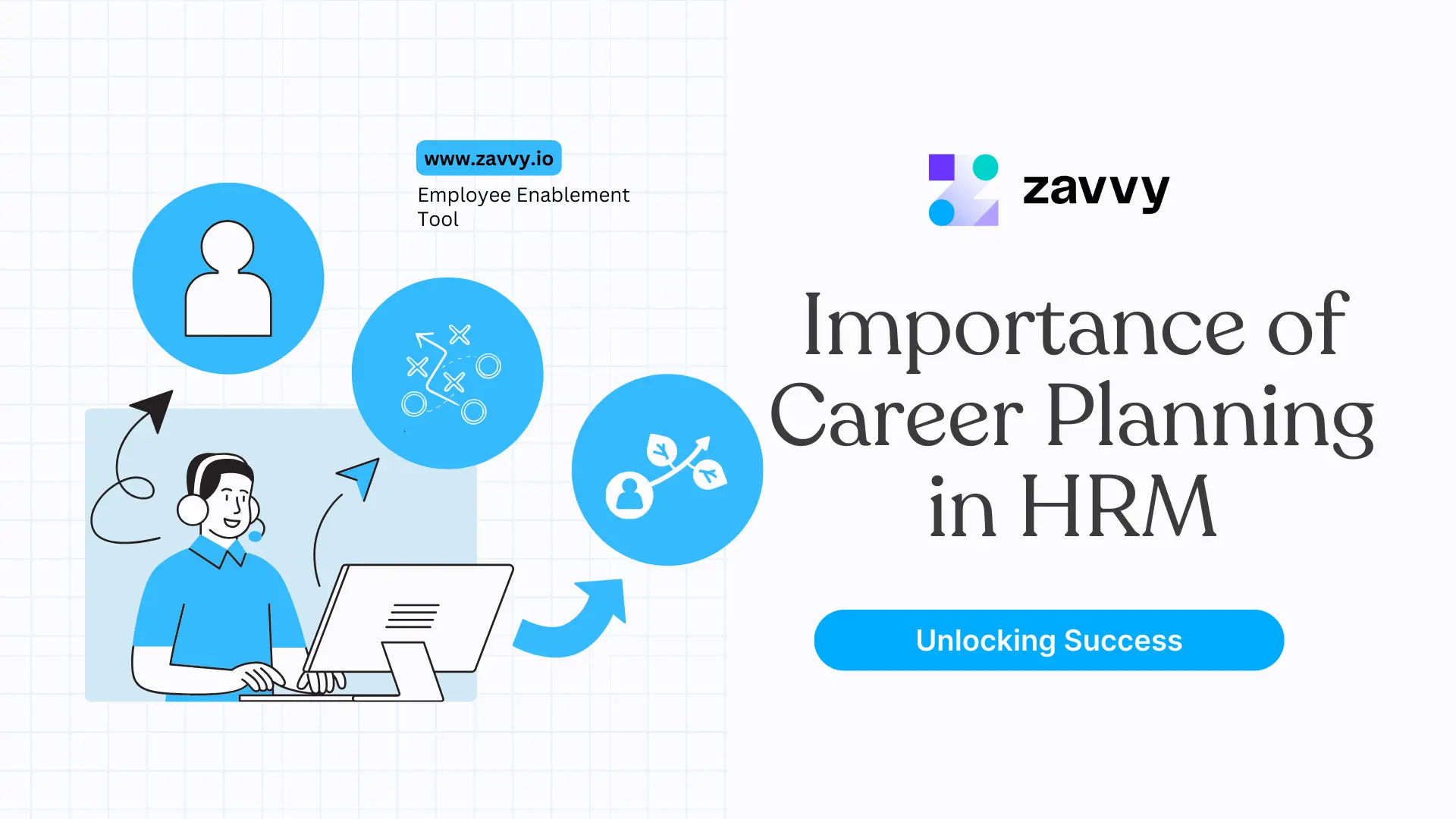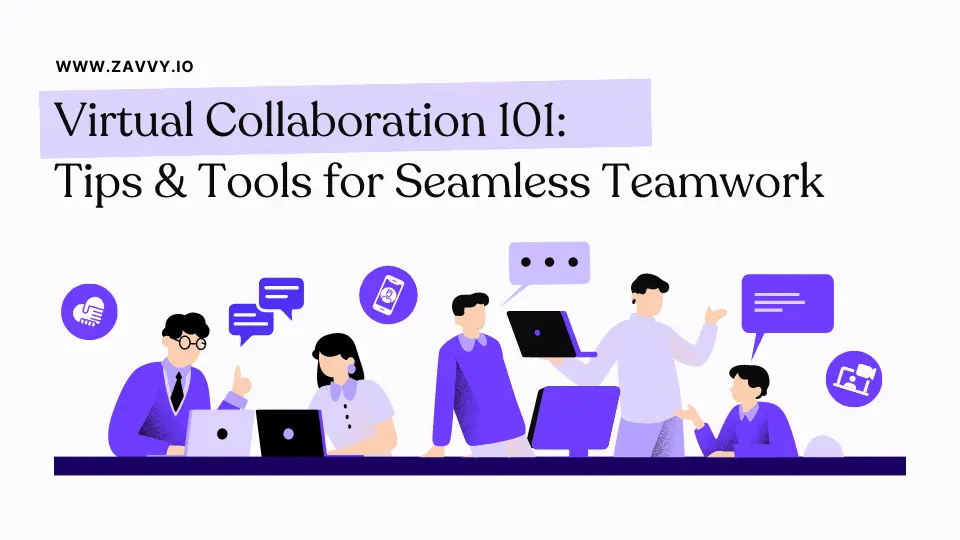
How to Conduct a 360 Performance Review: The Complete Guide
Zuletzt aktualisiert:
4.1.2024
Lesezeit:
12 minutes
última actualización
4.1.2024
tiempo de lectura
12 minutes
Last updated:
January 4, 2024
Time to read:
12 minutes

Feedback matters. Employee growth depends on it. But more often than not, traditional reviews fall short.
Cue 360 performance reviews, a modern method offering a well-rounded view of an employee's strengths and areas for improvement.
In this complete guide, we'll walk you through the ins and outs of conducting a 360 performance review. From planning to implementation, we've got you covered.
Team Zavvy has helped multiple companies launch their very first performance review cycles. So we have all the tips to help you succeed.

🔄 What is a 360 performance review?
A 360-degree performance review is a comprehensive evaluation method that gathers feedback about an employee's performance from multiple sources.
Unlike traditional performance reviews involving only supervisors and subjects, 360 performance reviews congregate peer feedback, insights from subordinates (upward feedback), and superiors, and, in some cases, even customers or clients. The employee also conducts a self-assessment as part of the process.
A 360 review polls all these different sources to deliver meaningful feedback about a subject.
360-degree feedback aims to avoid bias and skewed observations for a more accurate and fair assessment.
As an HR professional, 360-degree performance reviews can give you a better insight into employee performance by collecting more perspectives and opinions.

📈 How 360-degree reviews help performance
Implementing 360-degree reviews can have a significant impact on professional growth and cohesion in your organization. While it may not be a good fit for every company, here are some use cases for when it can really pay off.
Promoting culture change
A lot of employees don't look forward to performance reviews. Why? Here are some common reasons:
- They are worried they are underperforming.
- They fear their accomplishments go unnoticed.
- They feel they are being unfairly targeted.
360-degree reviews allow employees to experience the other side of the review process. For example, rather than just being the target of negative feedback, they have the opportunity to provide feedback to their fellow employees.
This will help them better understand the process so they can see that there is nothing malicious about the feedback they receive. Involving employees in conducting reviews promotes a feedback culture focused on career development, ridding the process of stress and uncertainty.

Improving team effectiveness
Since all employees are involved in giving and receiving feedback, they are more likely to provide thoughtful, practical suggestions.
In typical performance reviews, it is common for subjects to go on the defensive. However, in the case of 360 reviews, insights come from different perspectives. So, one could no longer suspect manager bias.
Your employees might also have an easier time receiving insights from their coworkers. So, your employees will be more likely to take the feedback to heart and work on improving.
There is a chance that rater bias or otherwise unhelpful reviews will filter in; they could result from personal disagreements, jealousy, or even a lack of experience with conducting reviews.
Tip #1: It may be a good idea to have HR monitor and review 360 performance reviews for any inflammatory submissions. You may need to address them with the survey taker, or you may want to create a guide to help with objective score-giving.
Tip #2: Empowering team members to give helpful feedback to their teammates benefits everyone. More perspectives will help uncover blind spots and provide opportunities for the team to improve.
Improving performance management
Performance reviews, especially in larger companies, can require a lot of resources.
Your people operations department can spend significant time reviewing data and conducting one-on-one meetings with every employee. While you have a specialized skillset as an HR professional to handle this duty, you also have other tasks beyond a constant rotation of performance reviews.
Crowdsourcing the review process to other employees provides many advantages:
- Distributing work among the entire company;
- Sharing multiple perspectives;
- Larger sample sizes give more accurate results.
Rather than leaving the entire process up to a single manager or department, involving others can make the process faster and more effective.
People operations can then analyze a more extensive data pool to deduce better solutions and more accurate results.
Tip: 360-degree reviews are a great way to improve performance management.
🪜 How to conduct 360 performance reviews in 11 steps

1. Schedule reviews regularly
For 360 performance reviews to produce thoughtful feedback, you should plan them on a consistent schedule.
Employees may not have time to give meaningful responses if a survey shows up like a pop quiz.
360 performance reviews should be pre-planned and, ideally, marked on a calendar as a reminder. This way, employees have time to formulate helpful feedback and carve out time in their schedule to fill out the survey.
2. Decide on focus areas
Knowing what you want to review is as important as the insights you collect.
Zappos, for example, links performance with adherence to cultural values.
For Google, OKRs play a vital role in their performance management system.
Your 360 review forms could include questions reviewing employee's skills as a proxy for the employee's performance. You could focus on skills such as:
- teamwork;
- leadership skills;
- efficiency;
- interpersonal skills.
Another strategy could be evaluating each employee's strengths.
There's no right or wrong here. It's just a matter of being clear about how you measure and manage performance in your company.
3. Formulate your questions
You can choose to carry single-theme reviews throughout the year.
Alternatively, you could use a list of standardized questions in each survey that cover each area in a more general sense. Taking this approach will allow you to collect comparable data and reference it when analyzing employee progress.
Here are some performance review questions you can add:
- In what areas has the employee exceeded expectations? What specific examples can you provide to illustrate their achievements?
- How effectively has the employee collaborated and communicated with their colleagues and team members?
- How has the employee contributed to the success of the team or project? Can you provide specific examples of their positive impact?
- In what areas do you think the employee could improve, and what specific suggestions do you have for their development?
- To what extent does the employee seek out opportunities for improvement? Rating scale: 1 (Rarely) - 5 (Consistently)
- How effectively is the employee in meeting deadlines without compromising the quality of their work? Rating scale: 1 (Needs Improvement) - 5 (Highly Effective)
- How well does the employee demonstrate flexibility when faced with unexpected challenges or obstacles? Rating scale: 1 (Poor) - 5 (Excellent)
One best practice is to incorporate questions assessing role-specific competencies into your performance review.

➡️ Get inspired by 59 of the best performance review questions.
💼 Also check out these 44 360 degree feedback questions for leadership.
4. (If relevant) Define your rating scale and document it
A grading system can help you track and compare scores in a way that open-ended questions cannot.
For example, this is a popular scoring system:
1 - Lacking 2 - Below average 3 - Average 4 - Above Average 5 - Excellent
Not only does this system provide some general metrics for each score, but the numbers can be averaged or totaled for a final score.
You can use this score to track performance over time or even compare one employee to another.
But understanding why a reviewer (person providing feedback) left specific ratings can be as helpful as the ratings themselves.
When feasible, allow survey takers to include explanations beyond just a rating. It will help you understand the "whys" behind each rating, thus enabling more detailed feedback.

5. Prepare guidelines for reviewers
Whatever methods you use, include guidelines to reduce subjectivity.
Consider this question:
Did Employee A achieve their goal of better communication with the team this quarter?
[ ] Yes [ ] No [ ] Somewhat (_________________________________)
Compared to this one:
Rate Employee A’s communication skills (circle one):
A+ A B+ B C+ C D+ D F
The problem with the latter is the scoring system is more subjective. One survey taker may consider a “C” an adequate score while another may have higher expectations. Providing more direction and clear-cut questions will produce more actionable results.
Tip: A quantifiable score is helpful for people operations, but delivering constructive feedback is the end goal.
➡️ Here are some constructive employee feedback examples you can use for inspiration.
An extra step you can take to ensure objectivity is review calibration.
6. Choose who will assess each employee
Try to get as even of a distribution as possible.
For example, you can ensure that each employee gets results from one superior, two peers, and three subordinates.
You can then take the results and average them together or analyze them to deliver actionable feedback.
Tip #1: You can conduct 360 degree feedback anonymously or openly.
🔎 Explore the arguments pro & against anonymous feedback before committing to either option.
People ops (or other feedback cycle admins) should track submissions in either case, but the subject need not know who reviewed them.

Tip #2: It is also important to mix it up so that it is not the same people reviewing each other every time. Rotate as much as possible.
7. Finalize and send out your performance review form
Assessment questions? ✅
Rating scales? ✅
Guidelines for reviewers? ✅
Now it's time to bring all of these together into your performance review form. And send it to your employees.

8. Have everyone self-evaluate with the same survey
Self-evaluation can be a vital tool for performance reviews. If you want the full spectrum of perspectives and opinions, don't forget that of the subject themself!
Having each employee answer the survey for themself gives you opportunities to compare their perspective to those of others.
These discrepancies can be significant focus areas.
Self-evaluation results also identify the areas an employee knows they need to work on or the places they wish to improve upon.
9. Define your timeline
Again, you should schedule 360-degree performance reviews so that survey takers have sufficient time to formulate meaningful responses.
Delivering a survey and requesting it back by EoD may result in uninspiring answers.
Ideally, employees should receive a heads-up on review scheduling.
Tip: Allocate at least a few days for reviewers to complete their surveys.

💡 Check out our guide with additional tips and best practices for running 360 performance reviews.
10. Review ratings with the employee
Once all surveys are submitted, HR can review them and tally the scores into a final report.
On Zavvy, each employee gets an individual performance report and competency profile at the end of the review cycle that the manager can help interpret.

Tip #1: Compare coworker scores to the self-evaluation to identify significant discrepancies that may be worth discussing.
You can ask the subject if they are satisfied with their scores or disagree with any of them and why.
It is common for employees to accept their scores but want further insight into what they did well or poorly to deserve them.
👀 Note: 360 performance reviews determine what needs improvement, but it is up to you to figure out how.
11. Next steps: planning for improvement and growth
You can also use 360 insights to formulate development plans that can include more training, upskilling, or coaching.

🏋️ Check out our collection of development goals examples.
💪 We also recommend having a look at strength-based goals and how they can supercharge your people's performance.
Be sure to offer support to turn low scores into opportunities for improvement.
Feel free to schedule informal follow-up meetings to ensure that employees make progress and reach their goals.

🔍 Pros & cons of 360 performance reviews
In addition to the advantages of more data, here are some specific pros and cons of instituting a 360-degree feedback process.

While there are many benefits to implementing 360 performance reviews, you should consider the resources needed to run them effectively.
It requires time for everyone in the company to learn the process and fill out surveys. It may also require an arbiter to review and deliver the results. This person will likely handle traditional performance reviews, meaning you are adding steps to the review process.
However, the results are often worth it. Getting everyone involved in the review process:
- Encourages an open feedback culture where upward and downward feedback bring value.
- Levels the playing field so everyone plays a role in performance reviews, and no one feels targeted.
- Helps with accountability and team cohesion, as everyone works together on personal and organizational growth.
💼 360 Performance reviews: 7 Best practices for managers
#1: 360 performance reviews can be new to many employees, so don't leave them in the dark.
In addition to explaining how a 360 review works, offer coaching or a mentorship program that covers giving constructive criticism. It may be second nature to you as an HR pro, but the concept may be new to some.
➡️ Check out our Comprehensive guide to giving constructive feedback.
#2: Share any documentation about rating scales, goals, and focus areas to ensure all surveys share the same point of reference.
#3: You should also be prepared to act on survey results.
It is not enough to deliver scores from the surveys. You need to make use of that data to come up with action plans and solutions for improvement.
#4: The surveys should be a vehicle for starting a discussion, not the end of the conversation. So be prepared to answer questions, offer guidance, and set goals for the future.
#5: Avoid discounting any surveys or identifying anonymous submissions.
While you are free to void surveys you feel are disingenuous or slanderous during the review phase, anything presented to the subject should be considered legitimate.
#6: You should also avoid agreeing or disagreeing with the reviews. They are objective data that you should use for gaining insight, not opinions to agree or disagree with.
#7: Lastly, don't make performance reviews a competition. Each individual's results are for their improvement, not to gauge if they are better or worse than their coworkers.
➡️ Run 360 performance reviews on autopilot with Zavvy
Our 360 performance review software has everything you need to implement insightful performance reviews. You can:
- Easily choose sample questions.
- Decide your reviewers, and reviewees in just a few clicks.
- Once you have chosen your settings and review criteria, automation tools handle most of the legwork without HR intervention.
- Easily collect insights from managers, direct reports, peers, as well as self-evaluations.
- You can then review the results and deliver feedback all in one place.
No more wasting time with cumbersome spreadsheets or shared documents.
Just initiate the feedback process, and employees will receive reminders to submit their reviews.
Once the surveys are in, you can identify improvement areas, set development goals, and help employees grow within your company.
Intrigued? Book a free 30 minutes demo to see it all in action.

❓ FAQs
Who benefits from a 360 degree performance review?
A 360-degree performance review benefits multiple parties within an organization:
- Employees: They receive comprehensive feedback for personal and professional growth.
- Managers: They gain diverse perspectives to better support their team members.
- Teams: The process fosters open communication, improving team dynamics and collaboration.
- HR and leadership: Insights help with data-driven decisions on talent management and succession planning.
- The organization: Improved engagement, satisfaction, and productivity contribute to overall success.
How often should you conduct 360 performance reviews?
The frequency of conducting 360-degree performance reviews depends on your organization's needs and goals.
However, it is generally recommended to conduct them once a year. This allows enough time for employees to:
- Implement feedback.
- Develop new skills.
- Demonstrate progress in their performance.
In addition to the formal 360-degree performance reviews, we encourage you to offer ongoing feedback and communication through regular check-ins and one-on-one meetings.
Offering support between performance review cycles helps maintain a culture of continuous learning, growth, and improvement.
What can I use to enhance the quality of 360 performance reviews?
Here are a few strategies to enhance the quality of 360 performance reviews:
- Use open-ended questions: Incorporate open-ended questions enabling reviewers to share more detailed and nuanced feedback.
- Use software to help conduct surveys and compile the results for easy analysis. This data will provide valuable insights to frame professional development plans and guide performance reviews for more significant effects.
- Clearly communicate the purpose, process, and expectations of the 360-degree review to all participants, emphasizing the importance of providing honest, constructive feedback.
- Train reviewers: Ensure that all reviewers understand the process, have guidelines on how to provide feedback effectively, and understand confidentiality requirements.
- Help recipients interpret results: Ensure that the recipients understand how to receive feedback and how to take action on it. Your goal is to ensure that they will use the feedback constructively.
Read next
Als Nächstes lesen
No items found.
No items found.
.png)





















.png)
























